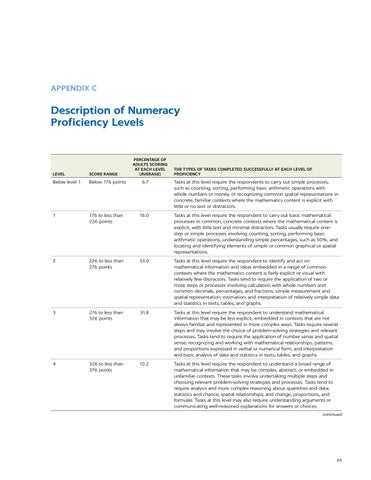APPENDIX C
Description of Numeracy Proficiency Levels
LEVEL
SCORE RANGE
Below level 1
Below 176 points
1
PERCENTAGE OF ADULTS SCORING AT EACH LEVEL (AVERAGE)
THE TYPES OF TASKS COMPLETED SUCCESSFULLY AT EACH LEVEL OF PROFICIENCY
6.7
Tasks at this level require the respondents to carry out simple processes, such as counting, sorting, performing basic arithmetic operations with whole numbers or money, or recognizing common spatial representations in concrete, familiar contexts where the mathematics content is explicit with little or no text or distractors.
176 to less than 226 points
16.0
Tasks at this level require the respondent to carry out basic mathematical processes in common, concrete contexts where the mathematical content is explicit, with little text and minimal distractors. Tasks usually require onestep or simple processes involving counting, sorting, performing basic arithmetic operations, understanding simple percentages, such as 50%, and locating and identifying elements of simple or common graphical or spatial representations.
2
226 to less than 276 points
33.0
Tasks at this level require the respondent to identify and act on mathematical information and ideas embedded in a range of common contexts where the mathematics content is fairly explicit or visual with relatively few distractors. Tasks tend to require the application of two or more steps or processes involving calculation with whole numbers and common decimals, percentages, and fractions; simple measurement and spatial representation; estimation; and interpretation of relatively simple data and statistics in texts, tables, and graphs.
3
276 to less than 326 points
31.8
Tasks at this level require the respondent to understand mathematical information that may be less explicit, embedded in contexts that are not always familiar and represented in more complex ways. Tasks require several steps and may involve the choice of problem-solving strategies and relevant processes. Tasks tend to require the application of number sense and spatial sense; recognizing and working with mathematical relationships, patterns, and proportions expressed in verbal or numerical form; and interpretation and basic analysis of data and statistics in texts, tables, and graphs.
4
326 to less than 376 points
10.2
Tasks at this level require the respondent to understand a broad range of mathematical information that may be complex, abstract, or embedded in unfamiliar contexts. These tasks involve undertaking multiple steps and choosing relevant problem-solving strategies and processes. Tasks tend to require analysis and more complex reasoning about quantities and data; statistics and chance; spatial relationships; and change, proportions, and formulas. Tasks at this level may also require understanding arguments or communicating well-reasoned explanations for answers or choices. continued
65

